For many years I’ve seen incredible baskets from the Philippines— mostly at Cost Plus stores, yard sales, or at Goodwill. But after visiting indigenous basket making communities in Indonesia and Malaysia, I realized that many of the baskets woven in their communities had a lot in common with those of the Philippines. It turns out that many native communities in all 3 countries have similar historical origins.
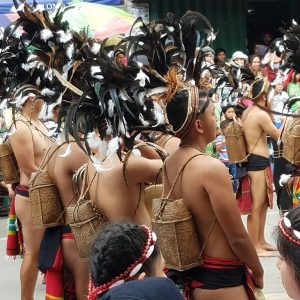
Bontoc backpacks on dancers in Mountain Province Lang-Ay festival
Last year, after seeing an amazing exhibit in downtown San Francisco of indigenous textile from Mindanao Island in the Philippines, I was inspired to pursue the Philippine connection. Mary Connors, of the Textile Arts Council of San Francisco’s DeYoung Museum had organized a 2016 tour of the Philippines for textile weavers, but also had her own extensive collection of quality Philippine baskets. She put me in contact with the Non- Timber Forest Projects (NTFP) group based in Quezon City, near Manila, and through them I was able to make the connections for the journeys to the remote basketry communities I visited.
**************
In the Philippines, wages are low. The government minimum wage is approximately $10 daily in urban areas, and only $5 in the countryside. But in the most isolated rural areas—primarily upland indigenous communities—the minimum wage is meaningless; in these subsistence economies, virtually the only employment is on the family farm.
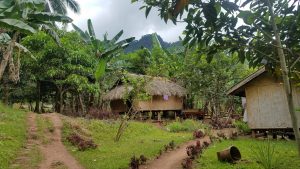
Kamantian house of thatched palm and bamboo
During a recent three week trip, I visited four indigenous communities on two islands: the Pala’wan on the island by the same name, and the Ibaloi, Tingguan, and Ifugao of the Luzon Cordillera ( Mountains). Three of the four villages were only accessible by hiking. Kamantian, the Pala’wan village, required a steep 4 hour mountain trek from the nearest dirt road.
These ethnic groups are culturally distinct, but share the experience of having been largely unaffected by four centuries of Spanish colonialism, and only marginally affected by the 5 decades of U.S. colonialism which followed. However, in the past century, indigenous communities have struggled to secure ancestral land rights and access to the very natural resources that have made their continued subsistence possible—including the rattan, bamboo, & various palms and vines used for basketry.
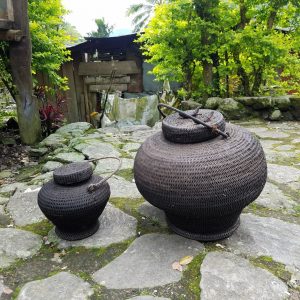
Still used rattan storage baskets in Ifugao village
In these agricultural communities, rice and root crops are raised with swidden (slash and burn) methods, and homes are built and furnished primarily with bamboo.
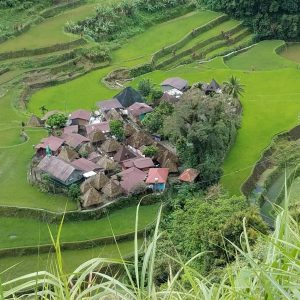
Ifugao basketry village outside of Banaue
Basketry and the weaving of textiles often provide the only cash income for necessities like cooking oil, soap, & school clothes. A beautifully crafted traditional basket of finely spliced and plaited bamboo may earn the weaver only $3.00, but this is essential income.
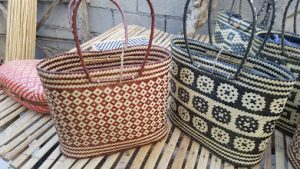
Tingguan tourist baskets of Bamboo.
The most striking basketry art in the villages I visited was in Pala’wan. Using bamboo, nito vine, and a softwood called enapung, the weavers create tourist trade miniature baskets with exquisite designs.
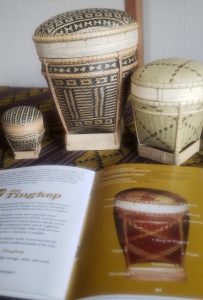
Pala’wan Tingkep basketry
These covered baskets, called tingkeps, were historically used for rice storage, as a hunter’s burden basket, and as spirit houses during animist rituals. 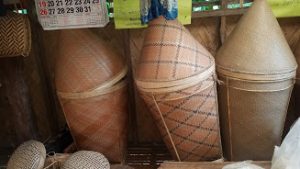
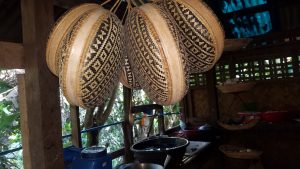
Now intricately plaited with smoked black and natural color bamboo, and lashed with the threads of the nito vine, the baskets come in symbolically significant & varied patterns. All the raw materials are found no more than a 5 minute walk from the center of the village!
Not surprisingly, it takes far more time to harvest and prepare the materials, than it does to weave the basket. Using only knives to split the 3” diameter bamboo stalks into dozens of 1/16” sized & finely smoothened strips requires enormous skill.
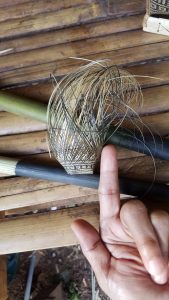
Tiny Tingkep basket
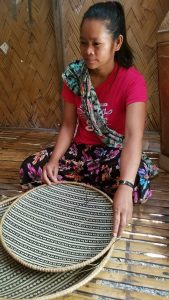
Pala’wan weaver and her trays
Basketry plays such a large role in the economy of the Ibaloi village of Banayakeo, that the local government and an NGO recently constructed a two room concrete block building as a meeting place for the Banayakeo Basket Weavers Association. In this building a “training on Banayakeo traditional bamboo crafting” was recently held to introduce a new generation of weavers to this important source of income, complete with awarded certificates and a speech by the provincial governor.
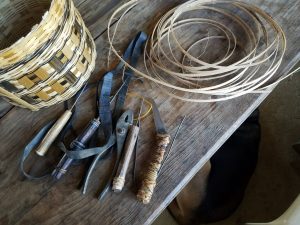
Ibaloi basketry tools
The weavers here have modified the size and shape their traditional bamboo burden basket, and modified the size and shape to create twined and plaited plant holders for market sales, as well as plaited baskets and helmet shaped sun hats.
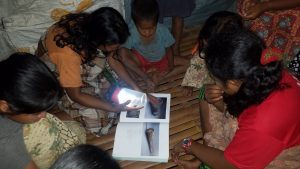
Ibaloi Banayakeo weavers studying pattern book
As with the Pala’wan weavers I worked with in Kamantian, the Ibaloi Banayakeo weavers were eager to see & learn new styles of basketry, and asked me detailed questions about my materials and techniques. They pored over the photos in the book I had brought, Basketry of the Luzon Cordillera, & asked that I teach them the technique I had used to make my coiled earrings. In her minutes, the association secretary particularly noted the materials I used— embroidery thread and paper rush— which, being store-bought goods, were unfamiliar. When I suggested they could attach beads to their coiled basketry, one weaver ran out & came back shortly with local bead-able seeds so that I could demonstrate. Like any group of U.S. basket makers, the Banayakeo weavers were looking for further artistic inspiration for their work, and I left promising to send them detailed instructions and further patterns for coiling.
In a typical instance where a traditional art form was transformed through cross-cultural exchanges, the basket weavers in villages outside Bangued city in Abra province were weaving plates and hats of finely cut bamboo with complicated & visually striking plaiting techniques that I had only previously seen in Japanese basketry. With a bit of research, I learned that Japanese volunteers had come to the region over a 15 year period beginning in the 1970’s to share their weaving techniques!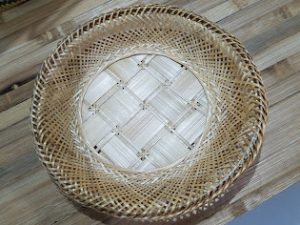
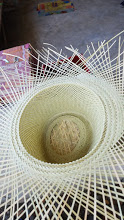
Tingguan tray and hat with Japanese wheel weave (rinko) technique.
Where the continuing geographical isolation of indigenous basket and textile weavers secures a ready supply of raw materials (which often must be prepared within a week of harvesting), it also means these communities lack access to markets, and must depend on intermediaries—tribal chiefs, mayors, or less altruistic business agents) to sell their goods.
This is why non-governmental organizations like Non-Timber Forest Products—the NGO that assisted me in my research— really make a difference. Their goal is to empower indigenous communities to be stewards of the forest, with continued access to both raw materials and markets. The work of groups like NTFP can take many forms.
For instance, in Pala’wan, the almaciga tree produces a resin used in smoking and blackening their bamboo for basketry. But the resin is also used widely used in lacquer, plastics, and paints, and can be profitably harvested, like maple syrup, on a sustainable basis. (Yes, the encaustic many basket weavers use to preserve their baskets contains this resin, commercially known as Manila copal.)
Thus, Pala’wanese NTFP community organizers are assisting resin harvesters to regain control of their lands and to obtain a needed government license for harvesting and sale.
Through the encouragement of the NTFP’s designing and marketing subsidiary, Custom Made Crafts, basketry and textile products which incorporate traditionally used forest materials, techniques, and patterns are promoted.
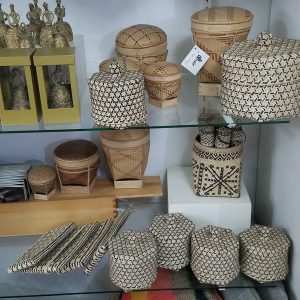
Pala’wan tingkep baskets in Custom Made Crafts display with basketry from Mindoro Island
And in weaving communities where basketry material has become scarce due to deforestation and climate change ( e.g. rattan), villagers are provided with the resources and technical assistance to re-introduce and cultivate them.
I was privileged to have made this Philippine journey, and profoundly impressed by the dedication of NTFP’s community organizers. My goal now is to assist with finding and shaping new markets for the basketry that is essential for the continuing survival of these indigenous communities. If any readers have ideas, I would love to hear from you!
**********
Although basketry has been my focus here, textile arts, including the traditional weaving of pineapple ( pina), banana & Manila hemp (abaca), & cotton fibers using ikat, tapestry, or shuttled techniques, & natural dyes, remain essential to the subsistence economies of many other indigenous Philippine communities—and are also supported by the NTFP. Please see the links below:
www.ntfp.org
Basketry of the Luzon Cordillera, Philippines, UCLA Fowler Museum of Cultural History, 1998.
Sinaunang Habi: Philippine Ancestral Weave, Marian Pastor- Roces (1991)
If in Manila, be sure to visit the National Museum of the Filipino People which has full floors of basketry and textiles exhibits, excellent explanations of the processing of natural materials and dyes, and a “Living Tradition” hall featuring the work and life stories of contemporary textile and basketry artisans.
***
Be on the alert!!! Another exciting Philippine textile exhibit, which will also include basketry, will open on September 17th and run through December 2nd, 2018, at the Mills Building, 220 Montgomery Street, in San Francisco. Mountain Spirits: Ceremonial Textiles and Folk Arts of Cordilleras & Northern Luzon is a further production of The Hinabi Project. See: thehinabiproject.org.